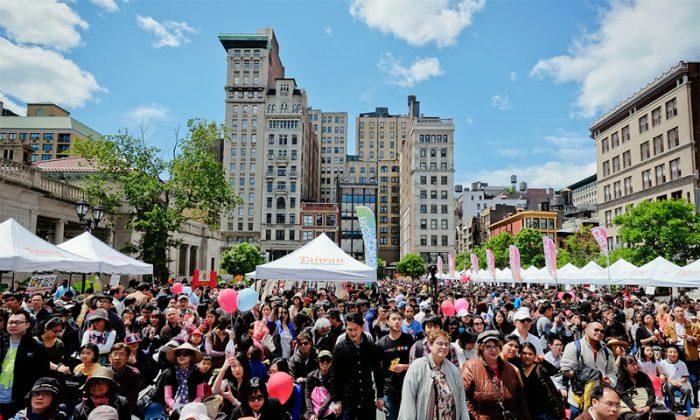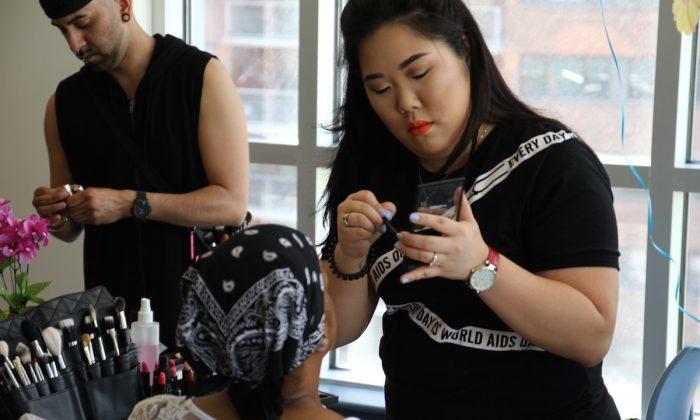When Wellington Z. Chen was young he migrated from country to country with his family, always an outsider, always starting over from square one.
He was once an architect, designing formidable skyscrapers with the famous Chinese American architect, I.M. Pei, who created a pyramid for the Louvre. But not before he was a student learning woodshop in the basement of a Queens high school, barely speaking English.
Now he faces his greatest challenge yet—saving Chinatown from escalating rents, scurrying rats, and the brain drain that bested the four other ethnic groups who used to have their own enclaves in the city.


Ephemeral
In Chen’s life, the phrase, “the ship is never meant to stay in the harbor” is a recurring theme. His life has been built on a series of chance encounters and precious moments.
Even his parents met in a stroke of good fortune. Following the communist takeover of China in 1949, his mother escaped to Taiwan on a ship. She met Chen’s father, the third mate. Both had attended school in the same Chinese province.
And, perhaps inspired by the roaming nature of the seaman, or driven to flee by the prevalence of poverty, hyperinflation, and a lack of opportunity, his family never stayed in one country for more than five years until Chen reached adulthood.
He was in Taiwan until he was five, then Singapore where his brother was born, Hong Kong, Brazil, and finally, the United States when he reached his teen years.
His life’s transience and fluidity gave him a lot of perspective to apply to problem solving: he has a thousand ideas for how to revitalize Chinatown.

Making Lemonade
After arriving in the United States, Chen hit the ground running.
At John Bowne High School in Flushing, school officials sent Chen to the basement woodworking class because his English skills were poor. But the language barrier didn’t stop him from applying his childhood talent of creating toy ships out of nuts and bolts.
The class required students to draw their wooden creations and the teacher even took them on field trips to architect’s studios. Chen remembers visiting Kevin Roche' and John Dinkeloo’s office in Hamden, Connecticut.
He described going down to the pitch-black basement of the giant mansion and flicking on the lights. He saw a crystal bridge, and glass buildings where every floor had “[miniature] furniture in it and human beings.”
He grinned. “So you can see why we got hooked.”
Chen became drawn to architecture from that moment in the Roche-Dinkeloo office, and many successive moments when he found the buildings, like the ideas of his ancestors, had an enduring quality to them.
“The building is likely to outlast you,” he said, hinting again at his desire to leave a mark on the world.
Chen finished architecture school at City College in 1985 and got a job at I.M. Pei’s firm. Pei was a modern master of the industry, and Chen was part of the design team for the seventy-story Bank of China in Hong Kong, and the ARCO Tower in Dallas, Texas. Many would have killed for the opportunity he had.
When asked why he left Pei’s after five years, Chen invoked the ship and harbor metaphor again with a grin. Then, he recalled returning to Pei’s office ten years later, where he observed a man he knew doing the same thing he had done a decade earlier. It wasn’t the sort of life Chen was interested in.

Chen worked at two other architectural firms, as vice president and then as president. He designed the building which is now the Tonga Mission to the United Nations and worked on affordable housing projects. But by 1990, his interest in architecture had taken a backseat to his aspiration of keeping neighborhoods alive, such as Flushing, and later, Chinatown.
He assumed many civic duties, spending five years as the commissioner at the NYC Board of Standards and Appeals where he reviewed thousands of land-use cases, and served as a senior consultant on the revitalization of contaminated brownfields.
In the meantime, he also served on the City University of New York and the Board of Trustees of the Metropolitan Museum of Art. He has accumulated dozens of awards for leadership and community service, such as a 10-year Community Board Service Award from former New York Mayor Ed Koch.
Flushing Fantastic
Chen applied a resilient problem-solving attitude to the distressed neighborhood where he had long lived. As high crime rates plagued the rest of New York City in the seventies, Flushing, Queens was fast becoming a ghost town.
Seeing his town falling apart, Chen wanted to stem the bleeding, so he joined the Flushing community board while he was still in architecture school.
“People have forgotten what Flushing was once like,” said Chen. “People would drill a hole through Citibank’s roof and you'd get robberies.”
What is now Macy’s was once a meth clinic where people outside would twitch on the ground on all fours. Homeless people embraced on the steps of the Flushing Town Hall, until a fence was put up. The northern end of Main Street was one vacant store after another.
And still the exodus continued: people rushed toward suburban neighborhoods to escape the daily panhandling and stabbings.
The community board threw a Flushing Fantastic street fair in the late 1970s. They barricaded the streets and persuaded department stores to open up again. By a combination of their efforts and the incoming waves of Taiwanese, Korean, and mainland Chinese immigrants in the ensuing thirty years, Flushing flickered back to life.

And those who left Flushing came to regret it, said Chen. They were overcome by “mental collapse, the pessimism.”
“I said, why are you running away? You think that if you run away no other groups can succeed here?” he said. “Oh, you’re wrong. Somebody will make it work here. The question is, are you going to be here?”
Flushing’s revival echoes Chen’s trajectory from small beginnings in the United States as a young boy who spoke little English to his achievements in architecture.
Both affirmed the possibility of success against the odds.
Chinatown
“In New York, I stepped through many worlds,” Chen reflected.
“I was a designer, I was a community advocate, I was a bureaucrat, I was a builder, I dealt with city red tape,” he said. All of it gave him a sense of what people were thinking; knowledge that aids him in his fight to save Chinatown.
From his experiences with Flushing and by keeping his eyes and ears open, now eight years into the job, Chen has thought up many methods of tackling Chinatown.
Chinatown’s main problem is its bad reputation as “dirty, filthy, dark, dingy, and full of rats,” he said. Part of his solution is to clean up its streets. He regularly hosts student volunteers—often from nearby Stuyvesant High School—to sweep the streets, wipe off graffiti, and plant tulips.

In October, he had a table at the New York Business Expo at The Javits Center—making no mention of rats or dirt—and sent out a newsletter, where he expounded on the twelve reasons why people should visit his neighborhood. He also attends business panels, where he shakes hands with prominent New Yorkers who greet him with a cheerful “Wellington!”
Chinatown’s case is pressing—the town’s population is aging.
The four other ethnic groups in history that once lived in present-day Chinatown—the Irish, Italians, Jewish, and Germans—have also met with the same fate. All four groups flourished to an extent, only to have their young grow up and move away.
Educated locals must start businesses that hire both young and old, said Chen, who says he has not seen this happen yet.
“The gold standard has never been, I raised this kid so that he can keep watch over this noodle shop,” he said. “No, you move on. And the minute you move on, we’re dead.”
Celestial Gateways
For decades, advocates have been agitating for a celestial gateway, as seen in the Chinatowns across the country, to greet entering tourists.
It’s a cause that Chen has backed, believing that it will help the neighborhood make its mark in the annals of time. He calls it a “spark” in dark times. Due to issues involving street space and traffic flow, the city’s Department of Transportation has not yet approved the plans.
Locals are also seeking to have a plaza built beside the red information kiosk between Canal and Baxter streets, but city officials have said that due to budget and space concerns, the kiosk would need to be demolished if the plaza were to be built. The kiosk was built with money from the federal government’s post-9/11 disaster recovery fund and community activists would be distraught to see it go.
Both requests are intricately connected with Chinatown’s sense of identity and its ability to sustain the ethnic community for years to come.

For its first two years, the Chinatown Partnership was located in Chelsea, unable to afford rent in its own neighborhood. Even now, it is in the process of moving to a more affordable location.
The lack of progress and seemingly impossible climb has taken its toll on Chen. Many days, he has found little time to eat, and he has gone out in the cold wearing only a thin jacket. His twenty-plus-year marriage fell apart soon after he became executive director of the partnership, and his ex has custody of his fifteen-year-old daughter.
He emails his daughter weekly, but can only see her once every other week when both have time.
“I have volunteers coming this weekend, so what can I do? Say, ‘You can’t come, I have to go see my daughter?’” asked Chen, furrowing his brow. “It’s the price you pay.”
Yet, no matter what the obstacles, Chen has a mission statement worth fighting tooth and nail for: “No other Chinatown has this kind of history or roots.”
He said that Dr. Sun Yat-sen, the founding father of the Republic of China, had once enjoyed a brief stay in town.
Could he let the home of so many simply vanish off the face of the earth?
He paused, leaning forward in his chair at his favorite coffee shop just across the street from his office, and continued: “No! Under your watch, and you didn’t do anything?”
The festivals and parades continue. On Dec. 13, a Saturday, the almost decade-old annual East Meets West Chinatown and Little Italy collaboration and all day party will be held from 1:00 p.m. to 6:00 p.m. at 114 Mulberry Street in an outdoor heated tent. There will be Italian and Asian singers, free hot chocolate, cookies, giveaways, and Santa Claus.





Friends Read Free